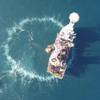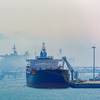The evolution of liftboats took a giant leap forward when Bollinger Shipyards, Inc., delivered the L/B MYRTLE, a 137.5-ft. liftboat to Montco Offshore, Inc., Golden Meadow, La. Equipped with 245-ft., legs, the self-propelled floating platform has the ability to work in water depths to 180 ft. with a 15-ft. air gap while lifting a total of 850 KIPS of variable load.
What makes the L/B MYRTLE different from other liftboats is that it is equipped with a bow thruster and controllable pitch (CP) propellers for greater maneuverability and pinpoint positioning of the huge legs with oversized pads on the ocean bottom.
Lee Orgeron, Montco’s president states, “We always strive to give our customers the best possible service with the highest level of safety built-in. The bow thruster, CP wheels and joystick operations give us the edge. With this high degree of control over the boat, we can more effectively avoid contact with underwater piping, can-holes, and other rig infrastructure.”
When asked why other liftboats are not similarly equipped, Orgeron replied, “Oh, that’s simple. This extra equipment is very expensive. We put it on the L/B MYRTLE to help our customers improve their bottom line, while it helps us to have satisfied customers.”
Orgeron said almost all liftboats use their main engines to either maneuver or operate the leg lift system while in neutral which interferes with positioning. “With this boat,” he said, “we can maintain jacking speed and maneuvering and hold a precise position at the same time.”
The vessel, named in honor of Myrtle Orgeron, mother of Lee Orgeron, is equipped with 40 foot by 16-foot pads, much larger than those on other liftboats, to provide for greater bottom stability and greater deck loads. The L/B MYRTLE can also jack with a full pre-load and its pre-load system has quick acting stainless steel dump valves .
It is equipped with three Nautilus cranes with 150, 50 and 25-ton capacities in an innovative configuration. The smaller crane is positioned on the starboard stern so that support vessels can tie-up to the liftboat and offload personnel, cargo, and/or fluids without hindering other work being done by the liftboat. The 150-ton crane has a 110-foot boom and is equipped with VHF radio, loudhailer, load indicator and boom-mounted video camera with monitor to assist when load hook-ups are out of the normal view of the operator.
“That is another indicator of the work we and Bollinger did to design the most efficient liftboat possible,” said Orgeron.
The boat is 137.5-ft. long, with a 92-foot beam and hull depth of 13-feet. Open deck area is 6,000 square feet. Its three legs are 72 in., in diameter and constructed of 1½-in., wall thickness high strength steel. Power is supplied by two Caterpillar 3512 diesels developing a total of 3,000 BHP. They drive Berg controllable pitch propellers through Reintjes reduction gears. Electrical power is produced by two 190 KW generators driven by Caterpillar 3306 diesels. A 350 BHP hydraulic motor drives the bow thruster.
The Hydraquip jacking system is designed using the latest hydraulic and computer technology to accurately control the leg position. The programmable logic controller provides all jacking system logic, safety interlocks, leg position and alarm monitoring. The hydraulic system incorporates a three speed jacking system that allows leg tagging at 10 ft/min, normal jacking at 4 ft/min and preload jacking at 2 ft/min. The jacking system has counterbalance (holding) valves at each motor for pinion isolation. All jacking system pressures, system status, temperatures, alarms, and operation manual are displayed on a liquid crystal plasma touch screen.
The boat’s fully equipped galley can serve 20 persons per seating and its 12 staterooms have 46 berths with three separate digital satellite television systems piped to 12 locations throughout the vessel.
Navigation equipment includes radars, depth sounder, loudhailer, a GMDDS station, magnetic compass, wind speed and direction indicators, 2 VHF radios, a SSB radio, a global positioning system, dynamic positioning system and autopilot.
Regulatory classifications are ABS loadline, SOLAS/MARPOL, USCG Subchapter L.
Some capacities are: 27,880 gallons fuel; 14,875 gallons fresh water; 250 gallons lube oil; 1,000 gallons hydraulic oil; 250 gallons crane hydraulic oil; 250 gallons dirty oil; 250 gallons oily bilge water, and 13,500 gallons zero discharge tank.
Subscribe for
Maritime Reporter E-News
Maritime Reporter E-News is the maritime industry's largest circulation and most authoritative ENews Service, delivered to your Email five times per week










